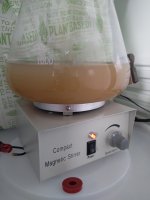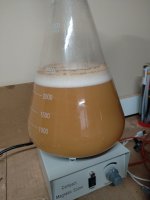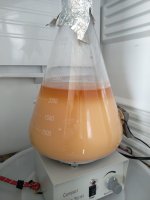Garrett_McT
Seeker of Knowledge, and Homebrew
Dear HBT Community,
I am going to attempt to propagate my first yeast culture in a starter. I read through the propagation section of the book titled Yeast by Chris White and Jamil Zainasheff. My understanding of White Labs pure pitch vials is that they have a 4 month shelf life. Using BeerSmith I am anticipating the following parameters
Beer Parameters
Batch Size = 2.5 gal
OG = 1.048
Yeast Cells Needed = 113.7 billion cells
Yeast = White Labs American Hefeweizen Ale WLP320
Yeast Best By = Feb 19, 2021
Yeast Production Date = Oct 19, 2020 (with my knowledge of 4 month shelf life)
Yeast Viability = 35.28%
Yeast Cell Count in Vial = 35.3 billion
Yeast Starter Parameters
My Desired Cell Count = 0.65*113.7 = 73.9 billion
Starter Gravity = 1.036
Starter Volume = 730 ml
This will be my first Hefeweizen, as well as my first starter. In the mindset of creating repeatable outcome, would propagating a culture in this fashion give similar results as to pitching straight from a vial? Essentially would this propagated culture create the same quality beer as a store bought pure pitch of the same cell count?
Also, would I be able to repropagate this same culture from bottom cropping the yeast slurry for a future iteration of the beer without sacrificing quality? Or would that be too much yeast duplication?
Thanks for Your Help,
Garrett_McT
[edit] I forgot to say that BeerSmith requires for the starter prescribed 3.04 oz of DME
I am going to attempt to propagate my first yeast culture in a starter. I read through the propagation section of the book titled Yeast by Chris White and Jamil Zainasheff. My understanding of White Labs pure pitch vials is that they have a 4 month shelf life. Using BeerSmith I am anticipating the following parameters
Beer Parameters
Batch Size = 2.5 gal
OG = 1.048
Yeast Cells Needed = 113.7 billion cells
Yeast = White Labs American Hefeweizen Ale WLP320
Yeast Best By = Feb 19, 2021
Yeast Production Date = Oct 19, 2020 (with my knowledge of 4 month shelf life)
Yeast Viability = 35.28%
Yeast Cell Count in Vial = 35.3 billion
Yeast Starter Parameters
My Desired Cell Count = 0.65*113.7 = 73.9 billion
Starter Gravity = 1.036
Starter Volume = 730 ml
This will be my first Hefeweizen, as well as my first starter. In the mindset of creating repeatable outcome, would propagating a culture in this fashion give similar results as to pitching straight from a vial? Essentially would this propagated culture create the same quality beer as a store bought pure pitch of the same cell count?
Also, would I be able to repropagate this same culture from bottom cropping the yeast slurry for a future iteration of the beer without sacrificing quality? Or would that be too much yeast duplication?
Thanks for Your Help,
Garrett_McT
[edit] I forgot to say that BeerSmith requires for the starter prescribed 3.04 oz of DME
Last edited:






























![Craft A Brew - Safale S-04 Dry Yeast - Fermentis - English Ale Dry Yeast - For English and American Ales and Hard Apple Ciders - Ingredients for Home Brewing - Beer Making Supplies - [1 Pack]](https://m.media-amazon.com/images/I/41fVGNh6JfL._SL500_.jpg)


































